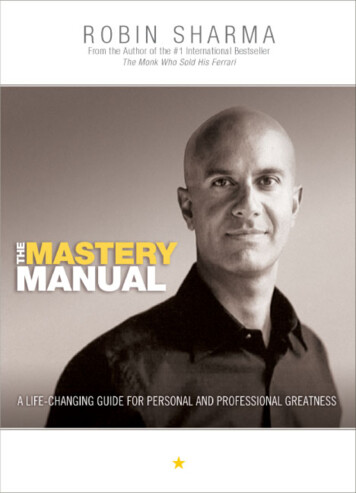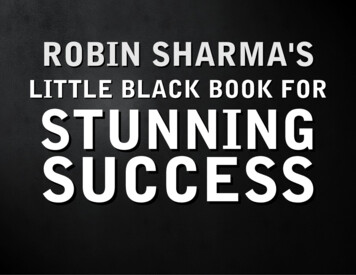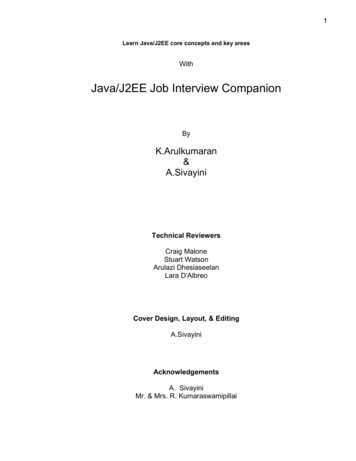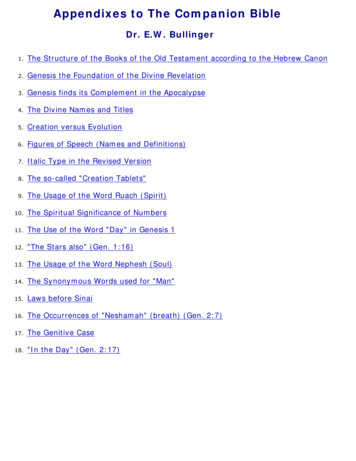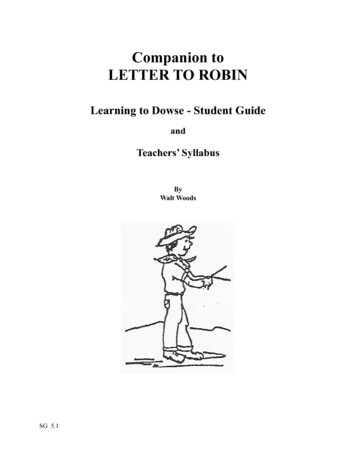
Transcription
Companion toLETTER TO ROBINLearning to Dowse - Student GuideandTeachers’ SyllabusByWalt WoodsSG 5.1
Companion toLETTER TO ROBINLearning to Dowse - Student GuideandTeachers’ SyllabusbyWalt WoodsFifth RevisionNov. 2005A special thanks to Lea Kachadorian, Bob Sird, Kay Lamm, Mardi Gieseler, PennBell, Nicolas Finck, Mike Doney and the many other dowsers who have contributedtheir wisdom and understanding to make this book possible. Walter Woods, Nov. 2005, SG 5.1, may be copied in part or whole for personaluse, for friends or clubs. It may not be copied for use in or as a for-profit sale itemwithout written permission from the author.SG 5.1First Edition Aug.2005, revisions Sept. Oct. Nov.
Table of ContentsINTRODUCTION1What is Dowsing?1Who Can Dowse1Getting Started2Dowsing Tools3Types of Dowsing Charts5How to Use Dowsing Tools6Introduction to Programing7Three Steps to Programing7Example Programs8Primary or Foundation Program8Request for Guidance Program9Water Program9Asking Dowsing Questions11Practice Dowsing12What Next?14Word Definition15Introduction to Teachers’ Syllabus16Suggestions for the FirstTime Dowsing Instructor20Addendum - Energy Fields22Multipurpose Dowsing Chart24Hormesis Curve25
INTRODUCTIONThis Student Guide is for beginners or for persons who would like a dowsing tune-up for betteraccuracy. Ideally, you would be in a class with an instructor to guide, demonstrate and expand on theprinciples involved. If you don’t have an instructor, this booklet is designed so you can learn all byyourself or in a small group. This Guide is divided into simple progressive steps. And as you progressyou will be surprised how easy it is to learn to dowse, and how to increase accuracy.This Student Guide is complete unto itself, but for more advanced information there is a companionbooklet “Letter To Robin, A Mini-Course in Pendulum Dowsing” which is based on the input of over150 skilled dowsers. It contains a lot of concentrated information. They are in systematic progression,eventually leading to doing over 100 areas on yourself. By learning to dowse with this Student Guide,you will find “Letter To Robin, A Mini-Course in Pendulum Dowsing” very informative and easy toread.What is Dowsing?Dowsing is one of the many names used for apparently tapping into your Superconscious,Subconscious, Spirit Guides, or something like that. This is accompanied with some method fordetecting this information. This could be a gut feeling, the twitch of a muscle, or some type of controlledexternal device. Every culture in the world, clear back to cave drawings, has had some type of dowsing.Dowsing was often used to find life-giving water.Who Can DowseLet’s first look at the abilities of the Subconscious. If you think about it, have you ever had theexperience of staring at a person, then have them immediately turn and look right at you? Can yousometimes feel that someone is looking at you? Have you had the phone ring and you somehow know itwas Uncle Joe even though you hadn’t thought of him in a long time? And you were right. Have youever had a very good idea just pop into your mind, seemingly out of nowhere? Does your body suddenlyreact, like taking your foot off the accelerator and putting it on the brake almost before you are aware ofthe danger? Does a mother know if her child is in trouble, with distance not being a factor? These andmany other similar experiences have happened to almost every one. As you can see the Subconscious, orsome aspect of it, has excellent sensing and reacting abilities, including internal, up-close, or atapparently unlimited distances.Could you train or program your Subconscious or some aspect of it, to use many types of tools ordevices? Of course you can. You would be using the same method that you used to train or program yourSubconscious automatically to write your name, type, or play an instrument. Simply program yourSubconscious to express its available information with some type of indicating method or device. It isjust the same as training or programing your mind and Subconscious to do most any thing else. But likemost procedures, it will take practice to be, and stay good at it.1
Getting StartedSuggestion: For the beginner and experienced dowser, you may find the knowledge of a simplelittle trick found on page 6, (See *Note) which may help get you into the dowsing mode. Then do the“How to Use” on page 6, just to get your pendulum started. This will make it easy to follow theinstructions below.Your first dowsing for information experience should have positive, successful, fun results. Here is anoften overlooked point to consider. It is a very subtle, often an unrecognized area, and some even thinkit is silly. But physiologists tell us that first impressions are lasting impressions. The reason is that thefirst impression is what influences the next impression in the same area. This then becomes thefoundation for all future reactions in this area. If you have a positive experience, condition, reaction andhave success, this influences future responses. If you have a negative, not sure, questioning, fearful,embarrassing experience or failure, then this will have both conscious and Subconscious futureinfluences. First impressions can be overcome, but only with strong determination. Can you remembera very embarrassing experience you have had with a person? Notice how you react each time you thinkabout this person. Can you un-remember some things? A first try, embarrassing dowsing failure, infront of a group of people, may have this kind of reaction.When you first start dowsing for information, to help build your future dowsing success, try thefollowing procedures. This will only takes a few minutes.Pendulum and Chart: Using a dowsing chart, and with your Pendulum swinging toward the “Readyfor Question”, ask several questions that you know the answer to. This is so you visually, mentally,emotionally and Subconsciously experience the feeling of your Pendulum swinging to the right answerand success. It is OK to encourage the Pendulum. Even if you feel you are influencing the answer, it isstill the correct answer. You will be training your Subconscious. Here are some suggested questionsyou could try. Is my name Joe? (yes or no) Am I a Female? (yes or no). Do I live in Chico? (yes orno) . This sounds too simple, and quick to be true, but don’t underestimate the lasting effect you arebuilding on. Now it is OK to try some unknown fun areas. Enjoy.L-Rod: If you are in a class, ask your instructor to find and mark a water vein or energy zone. Nowwith your L-Rod(s) in ready position, straight ahead, go to the spot they marked and expect your rods toreact the same way the instructor’s rods reacted. You will experience visual, mental, emotional andSubconscious success. If you don’t have an instructor, find a water valve and go experience finding theknown pipe. Now since you have expressed a positive dowsing reaction you can go play and have fun.Note: In the future when you start to dowse, always start your Pendulum to swinging andthen let it take over. This is just like when you write your name you start your pen to moving, andit automatically takes over and writes your name. With the L-Rod, by swinging them or it into theready poison, does the same thing.2
Dowsing ToolsAll dowsing tools or devices work equally well. It all depends on what you are comfortable with.You may have a favorite pen you use to write letters, but almost any pen would work. The followingdrawings give you a general idea. There are additional illustrations in “Letter to Robin, A Mini-Coursein Pendulum Dowsing”.PENDULUMShape: Can be anything that you can hang on a string or chain.They can be any size, even as small as a paper-clip ona thread. The chain or string is usually about 3 to 4inches long.Materials: Anything you can find. Go by your feelings.How to use: Hold as shown. The usual response request is for:swinging straight forward for “yes”, sideways for “no”and at an angle for “Ready for question.” Feel free to instruct (direct,program) your dowsing system to respond anyway you like.Advantages: Easy to make. Easy to use. Very popular. Small enough to go in yourpocket or purse. Quick response. Excellent tool for dowsing charts ormaps.Disadvantages: Some problem in the wind or when walking. This problem can beovercome by requesting (pre-arranging, programming) the pendulum in aclockwise or counterclockwise direction to indicate the “yes” or “no”response.L RODS (Angle Rod, Swing Rod, Pointing Rod - - -)Shape: With or without a sleeve handle. The top wire can be four inchesto over two feet long. The usual length is aroundtwelve to sixteen inches.Material: Usually wire. A metal coat hanger is a good source.Welding rod is also a very popular material. You canuse just about anything you can bend into an L shape.3
How to use: Hold loosely in your hand with the topwire tilted slightly downward.When one L Rod is used alone, it acts as a pointer ora swing rod. It can be requested to pointtowards a target or direction, or to swingsideways when encountering a specifiedenergy field. (i.e. an aura or noxious zone)When using two L Rods, they are normallyprogrammed to: point straight forward for theready position, to cross for the “yes” response or when over a target, andto swing outward for the “no” response.Advantages: Easy to make. Easy to use, very versatile and popular. Works wellwhen walking over rough ground. They are generally not affected by mildwinds.Disadvantages: Not as easy to carry or conceal as a pendulum. Although, thesmall four-six inch ones can be put in your shirt pocket or purse.4
Types of Dowsing ChartsCharts come in every conceivable form that you can imagine. There are books of DowsingCharts. To start: look at the drawings below. This is all you will need most of the time for YES and NOquestions. You can use the “Ready for Question” line or simply start your Pendulum swinging in anarea away from any answer. This way you know it is not stuck over an answer.PENDULUM DOWSINGThere will be times when you want to know about Beneficial and Non-beneficial information.To do this, simply add some numbers to indicate the amount or level of any condition. If you wish, youcan, by just using your imagination or focused intent, add one or two zeros to the numbers. This allowsyou to use them for other projects, including percentages.5
How to Use Dowsing ToolsDowsers use many types of tools and devices. If you are in a class your instructor will probablyhave several types to play with. For now the most commonly used ones are the Pendulum, generallyused with Dowsing Charts, and the L-Rod. They are interchangeable and can be held and used in manywaysBecause this is a training or programing procedure, like training your Subconscious bioelectrical muscle system to use a screwdriver or a can opener, it is not critical how you hold thedowsing tool, as long as it is comfortable and functional. When you write your name with a pen, whichyou already have a program for, you start the pen and expect it to write your name. And it does. Youwill be training your fingers to move the Pendulum in the same way you trained them to write yourname. Don’t let anyone tell you that your fingers are not supposed to move. In the lab, if you take fastframe motion pictures, you can see these non-deliberate, Subconsciously controlled movements on anydowser. The motion is some times subtle and small, but it is there. If you make electrical measurementsof the muscles, the bio-electrical muscle signals are always there.*Note: Of course you can control the movement of dowsing tools, but you can also let theSubconscious control the movement. This is similar to writing your signature. One way to do this is totreat the pendulum or other tools like a person. When you ask a person a serious question you simplywatch and listen for an answer. If you think about what you do, you will notice that you go into a kindof silence, just watching and listening, without thinking, or even being aware of anything else, exceptthe response. When you dowse, try going into that silence and just watch and wait for the answer. (Thisis sometimes called a Dowsing Mode.) You will be amazed how well it works. Dowsing does takepractice, but can be learned rather quickly.Generally, you hold the Pendulum like in the drawing. (p.3) The length of the string or chainbetween your finger and the Pendulum determines how fast it moves. A string or chain held around 3 or4 inches long will usually give a good swing speed.How To Use: Now hang your Pendulum directly over the center of the or the bottom of the halfcircle and deliberately start the Pendulum swinging toward the “Ready for Question”. Physically makeit go. This is to start training your Subconscious bio-electrical muscle system. It will probably stop.Start it again, telling it to keep swinging on its own. This may take a little while. You didn’t train yourfingers to type or play a musical instrument in just a few strokes. Each time you deliberately start thePendulum swinging toward the “Ready for Question”, expect it to keep going on its own. It is OK if ittakes a while to make it work. You will be able to practice more later.Note: The swinging from the center towards the “Ready for Question” is the Indicating Half Swing.Ignore the back swing from the center away from “Ready for Question”. Pretend you can’t see it. Followthe “Indicating Swing” wherever it goes, even if it goes down to the bottom half on some types of circledowsing charts.6
Introduction to ProgramingPrograming or informing your Subconscious what you want is very simple. Every time youlearn something new, you have created a new, additional or add-on program. For example, you caninform your Subconscious to alert you to pick up a loaf of bread the next time you are in a grocerystore. It is capable of doing this. Or on a more permanent basis, to turn out the light each time you leavea
Types of Dowsing Charts Charts come in every conceivable form that you can imagine. There are books of Dowsing Charts. To start: look at the drawings below. This is all you will need most of the time for YES and NO questions. You can use the “Ready for Question” line or simply start your Pendulum swinging in an area away from any answer. This way you know it is not stuck over an answer.File Size: 2MBPage Count: 28



